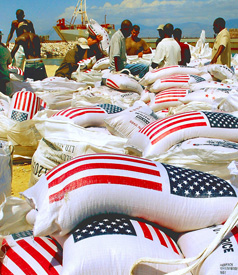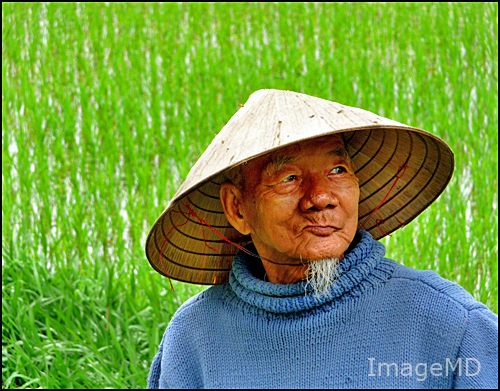Last week, we joined 75,000 people at a concert by U2 and its anti-poverty crusading lead singer, Bono. In the hour before the concert, random “hot facts” were flashed across a giant screen that surrounded the stage: how many people were born so far this year; how many cell phones were sold; how many days of oil were left; how many e-mails sent. It became a numbing cacophony of statistics that entertained the expectant fans.
We sat there with our 14-year-old son wishing that Bono, with all his smarts and notoriety, could instead have put on the screen facts to help people organize their thoughts toward a better way forward for our communities and our countries. How about listing which countries are feeding their people with healthy local food? Which ones have taken strides toward greater equality? Or which ones are lowering their carbon footprints?
Over the past year, in an effort to advance rootedness in this age of vulnerability, the two of us have traveled and looked into the many different factors that can make countries more or less rooted. We have just published an article in Third World Quarterly that offers 13 such measures, and appeals to United Nations agencies and governments to start measuring them. (Third World Quarterly is one of our favorite scholarly journals since it is carried in libraries around the world).
We begin our journal piece by pointing out some of what has made countries more vulnerable and less rooted:
Starting in the 1980s, under the guidance of key governments in the United States and Europe, the World Bank initiated market-opening ‘structural adjustment’ loans and the IMF used the opportunity of the Third World debt crisis to press countries to export even more and spend less. Poorer countries were likewise pushed to open their markets to financial firms. Other areas previously closed to foreign firms, like petroleum and cultural industries, were forced open through new trade and investment agreements. These efforts built on agriculture sector ‘modernization’ reforms (started in the 1960s), whereby technologies like the ‘green revolution’ promoted vulnerability in agriculture as farmers were enticed to ‘modernize’ by borrowing money to purchase imported chemical fertilizers, pesticides and even seeds.
By the turn of the 21st century, most countries were significantly open to global trade, investment, and finance. By 2007, for example, the value of trade (imports and exports) was greater than the value of GDP in 71 countries around the world. Only in Brazil, the United States, and the Central African Republic was trade as low as a quarter of GDP.
Our examination of these figures in the wake of the 2008 crisis suggests that many Western and Eastern European countries have both very high dependencies on trade, and suffered strong decreases in GDP in 2009. Likewise, the bigger Latin American countries that are most trade dependent (Chile, Mexico and Venezuela) all had GDP shrinkages in 2009. A key point here is that countries that were more vulnerable, like Mexico, suffered more in human and economic terms than countries that were less vulnerable, like India. Most African countries, less trade-dependent than other regions, grew in 2009, albeit at lower rates than before the crisis.
Since food is central to well-being, and since governments and the public are increasingly understanding the dangers of overdependence on food imports, we also argue that it is critical to measure the dependence of countries on food imports versus the overall availability of safe, affordable, local food for the population. It is shocking to see how many countries that were once self-sufficient in food have become dependent upon imports even for their most basic grain needs. Earlier this year, food prices spiked at levels even higher than in the crisis year of 2008, pinching pocketbooks in countries that cannot currently survive without food imports.
The majority of people in the developing world get most of their calories from grains – wheat, rice and corn — so we have especially looked at new data revealing which countries are most dependent on imports for their main grain.

Haitian farmers are resisting rice imports they say cripple their chances of real food security.
Here is what we discovered in recent data: Colombia and El Salvador are corn-eating nations, and they import more than 100 percent of consumption (this is possible because they feed a lot of corn to animals). People there are reeling from rising prices. Wheat is king in Jordan, Kuwait, and Jamaica, and each also imports more than 100 percent of consumption. Rice is the top grain in Haiti; it imports more than 80 percent of what its people consume. At the other end of the spectrum, India, Vietnam, and Ecuador are rice-eating nations but they import almost no rice. Argentina and Pakistan are wheat countries but they too grow what their people eat. Ghana and Togo are corn countries; they import almost no corn. The countries that are more self-sufficient are proving much more insulated from the global price shocks.
In our Third World Quarterly article, we examine many other ways to measure vulnerability versus rootedness, delving into the environmental, social, and economic aspects of these terms. We note that Yale University, for example, has teamed up with other institutions to put together 21 indicators of “environmental sustainability” that measure each country’s natural resource endowments, its resource extraction rates, its pollution flows, and the policy responses on each of these. Countries such as Finland, Norway, and Uruguay sit at the top of Yale’s sustainability index, while North Korea, Taiwan, and Turkmenistan lie at the bottom, on the unsustainable end.
Bono and U2: We would be delighted to help you pick “hot facts” that enable your audience to connect the dots towards more healthy, equitable, and sustainable – and, yes, rooted — futures.
John Cavanagh and Robin Broad wrote this article for YES! Magazine, a national, nonprofit media organization that fuses powerful ideas with practical actions. Robin is a Professor of International Development at American University in Washington, D.C. and has worked as an international economist in the U.S. Treasury Department and the U.S. Congress. John is on leave from directing the Institute for Policy Studies, and is co-chair (with David Korten) of the New Economy Working Group. They are co-authors of three books on the global economy, and are currently traveling the country and the world to write a book entitled Local Dreams: Finding Rootedness in the Age of Vulnerability. Over the decades, this husband and wife team has worked in a number of countries, including the Philippines, where Robin first lived in 1977-


